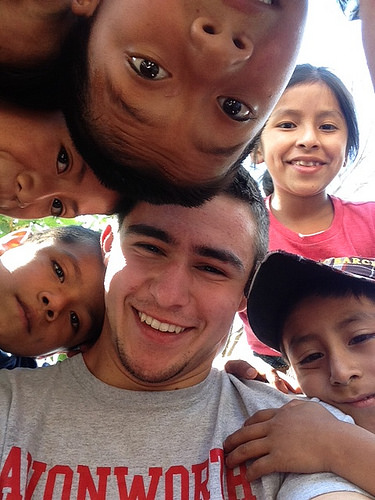 Shane with students from Chacaya
Shane with students from Chacaya When I arrived in Guatemala, I was amazed by how different everything was from the United States. Of course, I knew that life here would be strange compared to what I experienced every day at home, but I was taken aback by just how much I had underestimated the differences. The borderline recklessness of many of the drivers, the number of stray dogs, the number of women selling scarves and other woven items on the streets - just the sheer chaos of it all. And that was only Antigua.
After two days in Antigua, we took a long drive over mountainous terrain to Santiago Atitlan, where over the rest of the week we traveled to several different communities to visit schools, learn about Pueblo a Pueblo's projects, and experience firsthand what daily life is like for many Guatemalans. My fondest memory of this week will be my second trip to the school in Chacayá, where I was treated like a human jungle gym by a group of first through third grade students. It was easy to see how happy they were to have visitors, not to mention how interesting they found us given that we are foreigners.
In the afternoons, when school wasn’t in session, Catherine and I spent time making packs of clothing, translating storybooks into Spanish, and translating letters to sponsors from children in the communities. Reading the letters opened my eyes to the importance of Pueblo a Pueblo’s work. In them, kids thanked their sponsors and explained their living situations. Some had only one parent. Some had multiple younger brothers and sisters for whom they had to care. Most would never have been able to afford school without the help of Pueblo a Pueblo and the generosity of their sponsors.
During my time here, I’ve come to understand that there’s a difference between helping people for the common good – donating to charity, even volunteering at an organization like this – and getting the opportunity to experience firsthand what the work is doing. I came to this realization one afternoon towards the end of our stay when Catherine and I spent several hours jarring and labeling honey for Pueblo a Pueblo’s Beekeeping Project.
When we started, we thought that jarring the honey would be a long, exceedingly boring task. At first it was, as it took almost twenty minutes to fill one jar. After about an hour and a half, though, Felipa, one of the beekeepers, arrived and kept us company while we worked. The three of us talked for a while, joking around, sharing stories, and just passing the time.
During our conversation, Felipa told us that her husband had recently passed away and that she now had to care for her five children, ranging in age from five to fourteen, on her own. She works every day in the mountains near her house, hiking an hour or more each way, often carrying heavy loads on her back. She does all of this just to be able to support and provide for her family.
After hearing her story, everything that we had done this week suddenly became that much more meaningful, and jarring the honey, which at first seemed to be a boring task, became even enjoyable, now that we understood just how much we were helping Felipa.
Having had this experience and having seen just what life is like for so many people in Guatemala, I have a newfound appreciation for my home in Pittsburgh. This trip has been an eye-opening experience and certainly one that I will never forget, and what started out as a senior project has ended as something that changed both my life and my view of the world.

 RSS Feed
RSS Feed